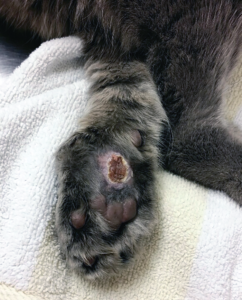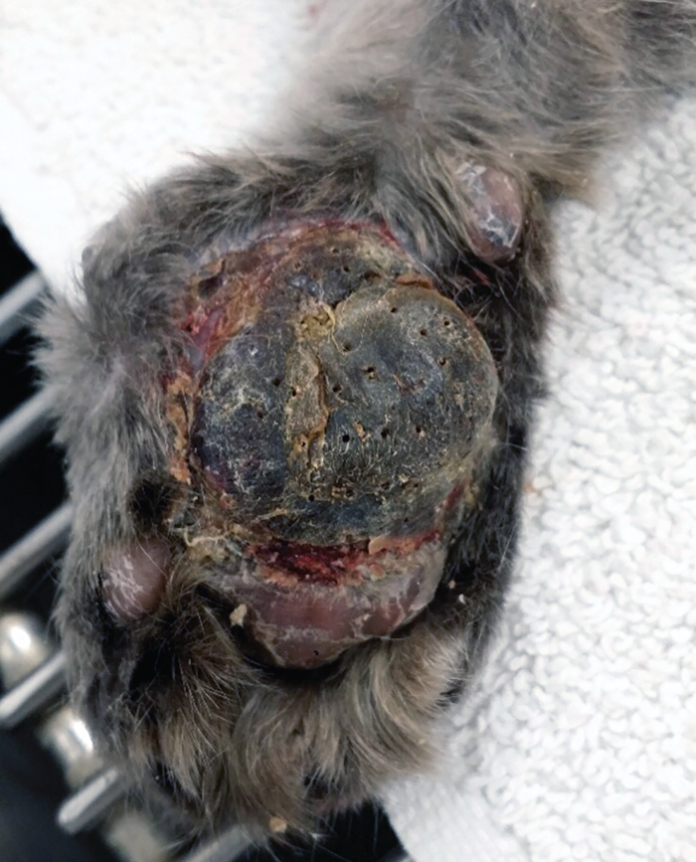Mast cell tumors are the most common feline cancer of the spleen, the second most common skin tumor (accounting for 8 to 21% of all skin cancers in cats), and third most common tumor identified in the intestinal tract of cats.
Mast cells are a type of white blood cell, part of your cat’s immune system. They are usually associated with allergic reactions, and they contain granules with enzymes, such as histamine, in them. These granules are released (called degranulation) as part of an immune-mediated inflammatory response that has evolved to destroy foreign invaders when mast cells encounter allergens that they have become sensitized to. The release of small amounts of histamine tends to cause sneezing and itching. A large release of histamine, though, can lead to whole-body symptoms, including anaphylactic shock, which is potentially life-threatening.
The cause of mast cell tumors is not well known, but environmental triggers are suspected. In dogs, there is a genetic mutation in a protein called KIT that is involved in most mast cell tumors. This mutation occurs in a protein that helps to regulate cell replication and division. About 67% of mast cell tumors in cats have this mutation.

Mast cell tumors in feline skin tend to be more benign and can often be cured with complete tumor removal. Mast cell tumors in the internal organs of cats, though, generally have a more aggressive disease course. About 15% of cats with splenic disorders have mast cell cancer of the spleen. When the intestines are involved, most cases are in the small intestine, but some have been diagnosed in the colon.
Most mast cell tumors appear in cats 10 years of age and older. These growths tend to be on the extremities (tail, limbs, head, and neck). They may develop as single growths or as multiple masses, and are generally pink, smooth or plaque-like, and associated with hair loss. In some cases, ulceration may occur.
For some unlucky cats, mast cell tumors may appear at a younger age, even in kittens. Luckily, many will regress spontaneously. This may take six to 24 months, so even in young cats, surgical treatment is often recommended.
What You Should Do
- Be aware of changes in your cat’s body, skin, mouth, and eyes.
- Get lumps and skin growths evaluated by your veterinarian.
- Watch for symptoms like itchy skin, lethargy, decreased appetite, weight loss, diarrhea, and vomiting.
Symptoms
Clinical symptoms vary with the location and type of mast cell tumor. Skin tumors may be static, but they also may cause your cat to itch or bite at the affected spot due to histamine release. Some of the masses will periodically increase in size and become quite red due to the degranulation. This can happen if your cat is able to rub or scratch the affected area on her body.
With splenic mast cell tumors, common signs include loss of appetite, weight loss, vomiting, diarrhea, and/or constipation. If the mass is primarily in the intestines, you may notice melena, which is black stool caused by digested blood that originates from ulcerations in the gastrointestinal tract. Abdominal mast cell cancer may cause a buildup of fluid in your cat’s abdomen.
Diagnostic Steps
Diagnosis of a skin mass may begin with a fine needle aspirate to provide cells for your veterinarian to stain and evaluate under a microsope. Your veterinarian may, however, decide that the best way to proceed is to go directly to a surgical biopsy, which means removing the mass.
Your veterinarian may be able to palpate an abdominal mass, and an abdominal ultrasound or radiographs may be recommended.
An important aspect of diagnosis of mast cell tumors is staging. This refers to a process that estimates how fast the cancer cells are growing, the size of the tumor, whether there has been spread to multiple parts of the body (metastasis), and whether any lymph nodes are involved in the tumor.
Staging usually requires careful microscopic evaluation of tissue samples, radiographs of the chest, and an ultrasound of the abdomen. Staging helps your veterinary oncologist determine prognosis and plan for appropriate treatment options.
With mast cell cancers in the spleen, removal of the spleen is usually important and may be curative in some cats. Unfortunately, even full surgical removal of intestinal masses does not usually impart a favorable prognosis.
Appetite can be an important prognostic indicator for cats with internal mast cell cancers. Cats with a healthy appetite when diagnosed may do well for some time, whereas cats that aren’t eating well when diagnosed often survive for much shorter periods of time.
Treatment Options
Treatment will vary with the stage/grade and location of the cancer. For skin growths with clear margins and a low grade, surgery may be curative. If additional mast cell masses appear, these can be removed as well.
Radiation therapy or chemotherapy have proven helpful in some cats. Radiation is most useful for localized growths, for which the radiation can be focused. Chemotherapy is most useful for mast cell cancers that have spread to multiple organs.
Supportive care is important for cats receiving treatment beyond surgery for mast cell tumors. Massive histamine degranulations can lead to serious problems, including shock. Corticosteroids and H1/H2 blockers may be part of the treatment protocol. (H1 and H2 blockers are antihistamines that help stabilize receptors on the mast cell.)
Along with splenectomy, there have been some studies that looked at chemotherapy as a follow-up for cats with this cancer. One study published in Veterinary and Comparative Oncology evaluated 64 cats with splenic mast cell tumors. These were older cats with an average age of 13. Four treatments were evaluated: surgery alone, surgery plus chemotherapy, chemotherapy alone, and supportive care alone. Chemotherapy included corticosteroids to help reduce histamine release side effects. In this study, splenectomy (alone or with chemotherapy) resulted in the longest survival time. The authors felt that further investigation of the use of chemotherapy would be valuable.
Electrochemotherapy is a new treatment modality that has been used for canine mast cell tumors. This therapy involves the simultaneous administration of chemotherapy drugs and the application of electrical pulses, which may increase the permeability of cell membranes to chemotherapeutic drugs. This modality may hold promise for cats in the future.
Bottom Line
Cutaneous mast cell tumors tend to be benign and can often be “cured” with surgical removal. Splenic mast cell masses have a much less favorable prognosis, but if caught early, surgery can significantly improve outcomes.




